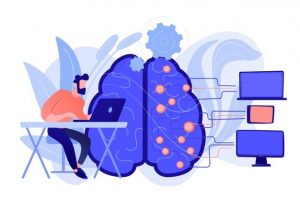In the part one of this article, here, we discussed about the general understanding of AI divided as ANI and AGI, ANI’s adoption and influence in the copyright law, and complexities arising out of the adoption of ANI while generating copyrightable works.
Further, let us understand the intricacies involved in the examination of ANI. What could happen if ANI generated works are granted copyright protection, and other complexities that could arise if ANI is left unsupervised.
Hassle in examination of AI:
With the growing trends of technology, it is crucial to have the appropriate yardstick to validate what constitutes AI/ANI. Since the 1950s, the prominent test adopted to examine machine intelligence was the Turing Test which presently stands outdated and parochial for limiting the range of the examination to communication and speech, which is easy to fulfil even by chat-bots. Whereas, the lady Lovelace’s test lays down that a machine can be considered intelligent if it is capable of surprising the observer of the outcome. Over the years, the Lady Lovelace’s test has faced criticism for being superficial. The machine can surprise humans, but it can be due to a bug in the software or hardware, and further because the human mind is subject to cognitive bias and it is a human mind preparing and examining the program. Therefore, leaving a larger room for an unintended faulty understanding of the software, may appear surprising, which should not amount to machine intelligence.
There is a general notion that certain software outputs are a surprise to the programmer due to an incomplete understanding of either the software or the programmer’s fundamentals, and these phenomena are called ‘black box’. Further, the incapability of the programmer to understand the functionality of ANI should not be the basis for determining intelligence in a machine.
Regardless of our limited understanding of technology, there is sufficient adoption of ANI in present times, and it is important to place accountability in case of violation of laws. Considering the vast range of activities that can be performed by ANI in a specific field, it is hard to place a blanket liability on the usage and adoption of ANI because it will constraint the development and growth of ANI. Presently, any tool which is claimed to be AI/ANI is merely an advanced software with higher computational abilities with the help of advanced hardware. Considering it is an advanced software, should we grant copyright protection to it?
Ambiguities and possible scenarios:

Let us assume for the sake of argument that ANI is granted copyright protection for producing a literary piece and eventually earns monetary benefits. So, can ANI purchase cloud storage services and replicate itself to produce further literary pieces and claim copyright protection over them? These questions do not have a conclusive answer and would have be decided on a case-to-case basis. The biggest hurdle faced by the courts is not being able to cope up with the fast-growing myriad facets of technology. Though, it is not viable to have a rigid approach to a fast growing and flexible technology by turning a blind eye to its tremendous impact on the economy and the society.
There are numerous questions left unanswered and partially understood by us about ANI/AI. But it is not feasible to allow the unregulated usage and adoption of AIN/AI considering the ability of ANI to generate materials infringing intellectual property law. Therefore, it is important to have a regulation to place appropriate liability on the adoption and usage of ANI.
Conclusion:
To conclude with, ANI or its programmer should be questioned on the logic/rationality adopted by the ANI while creating the work. This may help the courts asses the liability that could either be due to poor training data set or bad algorithms, and whether the reasons stated are bona fide or not in light with the rule of law. Further, it is important to understand the basic functionality of ANI to be better able to decide upon the matter, and a deeper understanding of the process is required to be equipped to better handle issues that may arise out of the usage of ANI. ANI in simple terms is an advanced software with higher computational abilities which may not amount to intelligence per se. But again, the definition of intelligence is unclear and therefore, it is not viable to grant copyright protection to ANI. There is a need for a comprehensive legislation governing the various aspects of ANI and in due course it is going to be inevitable to not have a legislation governing the actions of the ANI. As Companies Act, we will require an Artificial Intelligence Act.
A right start would be to have an inclusive definition of AI/ANI, the definition scope should be broad to cover newer functionalities and not have to frequently amend the laws. This will aid the courts and the government to place a wider accountability on usage and adoption of ANI, and not leave room for programmers to take advantage over the leaks in the system. Although, keeping in mind that the growth and development of AI is crucial and stringent laws should not be the hurdle.
This article has been authored by Abhishek R.
Editorial Staff
Editorial Staff at Selvam and Selvam is a team of Lawyers, Interns and Staff with expertise in Intellectual Property Rights led by Raja Selvam.
Court orders revival of opposition abandoned for not filing evidence in support on time when Counter Statement was not served
The petitioner had opposed the trademark applications of Respondent No. 2 for the mark “Travel Fox,” alleging its similarity to Coaster Shoes' own…
